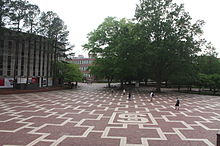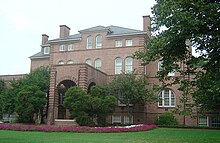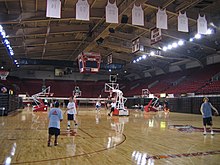
North Carolina State University is a public land-grant research university in Raleigh, North Carolina, United States. Founded in 1887 and part of the University of North Carolina system, it is the largest university in the Carolinas. The university forms one of the corners of the Research Triangle together with Duke University in Durham and the University of North Carolina at Chapel Hill. It is classified among "R1: Doctoral Universities – Very high research activity".

The University of North Carolina at Chapel Hill is a public research university in Chapel Hill, North Carolina. It is the flagship of the University of North Carolina system and is considered to be one of the "Public Ivies". After being chartered in 1789, the university first began enrolling students in 1795, making it one of the oldest public universities in the United States.
Shaw University is a private Baptist historically black university in Raleigh, North Carolina. It is affiliated with the American Baptist Churches USA. Founded on December 1, 1865, Shaw University is the oldest HBCU to begin offering courses in the Southern United States. The school had its origin in the formation of a theological class of freedmen in the Guion Hotel. The following year it moved to a large wooden building, at the corner of Blount and Cabarrus Streets in Raleigh, where it continued as the Raleigh Institute until 1870. In 1870, the school moved to its current location on the former property of Confederate General Barringer and changed its name to the Shaw Collegiate Institute, in honor of Elijah Shaw. In 1875, the school was officially chartered with the State of North Carolina as Shaw University.
Alvin Marcus Fountain was a former professor of English at North Carolina State University and a notable college historian.

Alexander Quarles Holladay LL.D. was an American lawyer, state senator and college administrator.

Technician is the student newspaper of North Carolina State University. Its first edition was published in 1920, and it has been published continuously since that date, becoming a daily paper in fall 1988. Since 2018, the newspaper has been published on Thursdays, with stories also published online throughout the week at http://www.technicianonline.com. The newspaper is funded by in-paper and online advertising and is a part of NC State Student Media. NC State's Student Media Board of Directors oversees NC State Student Media, which includes Technician, other student-led publications, and a college radio station, WKNC-FM.
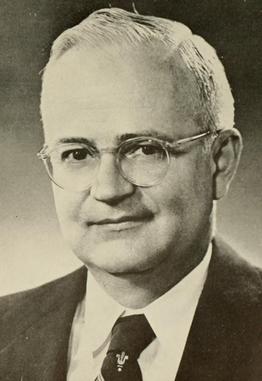
Carey Hoyt Bostian was an American educator. He was educated at Catawba College, where he earned a Bachelor's Degree in 1928, and at the University of Pittsburgh where he earned a Master's Degree in 1930 and a Ph.D. in 1933.

John William Harrelson was the sixth chief executive of North Carolina State College from 1934 to 1953. An artillery officer in the U.S. Army Reserve, he was the first N.C. State alumnus to lead the institution and the first leader of the university to hold the title of Chancellor.
North Carolina State University was founded by the North Carolina General Assembly in 1887 as a land-grant college under the name North Carolina College of Agriculture and Mechanic Arts. As a land-grant college, NC State would provide a "liberal and practical education" while focusing on military tactics, agriculture and the mechanical arts without excluding classical studies. Since its founding, the university has maintained these objectives while building on them.
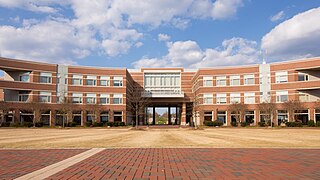
Centennial Campus is a research park and educational campus owned and operated by North Carolina State University in Raleigh, North Carolina, United States. Composed of two locations, the 1,334 acres (5.4 km2) property provides office and lab space for corporate, governmental and not-for-profit entities, in addition to providing space for 75 university research centers, institutes, laboratories and departmental units. Currently, 5,000,000 sq ft (460,000 m2) of constructed space has been built. Upon completion, Centennial Campus is anticipated to have 9,000,000 sq ft (840,000 m2) of constructed space.

University Plaza, or more commonly The Brickyard, is a public plaza at the heart of North Carolina State University's North Campus in Raleigh, North Carolina. It is the university's most active court and has been the site of numerous special events, including concerts, memorials, campaign rallies and political protests.

The Wolfline is an area bus service serving the students, staff, faculty, and general public on and around North Carolina State University's campus in Raleigh, North Carolina. As of Fall 2017, Wolfline is operated by Transdev, after being operated by First Transit between 2007 and 2017, under contract with NC State's Transportation department. The Wolfline was the first mass transit organization in the state to exclusively use 'clean' diesel engines. Wolfline access is unrestricted to the public and is a zero-fare service. The preceding contractor was Veolia Transport. The Wolfline began operating in August 1980 with one route.

The D. H. Hill Jr. Library is one of two main libraries at North Carolina State University. It is the third building to house the NC State University Libraries, following Brooks Hall and Holladay Hall. The current building, situated on the Hillsborough Street edge of North Campus, is the result of four stages of construction, and houses the majority of the volumes in NC State's collection.

Hillsborough Street is a business and cultural thoroughfare through Raleigh, North Carolina, United States. The street serves as a center for social life among North Carolina State University and Meredith College students.

The Free Expression Tunnel is the longest, widest, and most heavily used pedestrian tunnel under the railroad tracks at North Carolina State University in Raleigh, North Carolina. The special aspect of the tunnel is that anyone is permitted to decorate its walls, ceiling, and floor. The tunnel connects NCSU's North Campus with the Central Campus and provides the most direct route from The Brickyard to the Central Campus residence halls. Clubs, fraternities, sororities, and other organizations often paint the tunnel to promote events and amateur artists paint to express themselves and to promote freedom of speech. A retaining wall just outside the tunnel's south entrance is also open for free expression. The "service tunnel" itself was constructed in 1939 as a Public Works Administration project. The tunnel was first painted in 1968 when it was painted red and white to celebrate the military veterans of North Carolina

Over 8,000 undergraduate and graduate students live in campus housing at the University of North Carolina at Chapel Hill during a regular school year. Forty residence halls are grouped into 16 residential communities across campus.

The James B. Hunt Jr. Library is the second main library of North Carolina State University (NCSU) and is located on the university's Centennial Campus. The $115 million facility opened in January 2013 and is best known for its architecture and technological integration, including a large robotic book storage and retrieval system which houses most of the university's engineering, textiles, and hard sciences collections. The library is named after James Baxter "Jim" Hunt Jr., the four-term 69th and 71st governor of North Carolina. NCSU Libraries is part of the Triangle Research Libraries Network (TRLN), which shares books between North Carolina State University, Duke University, The University of North Carolina at Chapel Hill, and North Carolina Central University.

The Agricultural and Technical College of North Carolina Historic District is 10.1-acre (41,000 m2) historic district along the western boundary of the campus of North Carolina Agricultural and Technical State University in Greensboro, North Carolina. The area includes five historical Colonial Revival, Classical Revival style buildings. Some significant structures are among those located within the Historic District include the James B. Dudley Memorial Building and Harrison Auditorium. The district has been listed on the National Register of Historic Places since October 20, 1988.
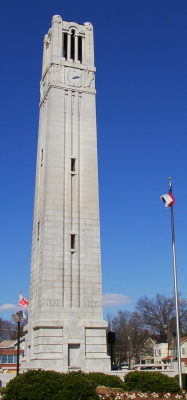
The North Carolina State University Memorial Belltower is a 115-foot-tall (35 m) free-standing bell tower on the Main Campus of North Carolina State University in Raleigh, North Carolina Conceived as a war memorial to honor university alumni killed in World War I and the university's overall participation in the conflict, the Belltower now serves as a perpetual memorial for N.C. State students and alumni who gave their lives in the service of the nation. A prominent university symbol, the tower is a popular rallying point for the campus community.

The Gregg Museum of Art & Design is the art museum of North Carolina State University and is located near NC State's main campus in Raleigh, North Carolina. To current NC State chancellor Randy Woodson, the Gregg is "an opportunity to not only celebrate the arts and design at NC State, but to welcome the community onto our campus in a new way." The Gregg holds exhibitions, lectures, workshops, film screenings, and other educational activities; admission to the Gregg is free.


